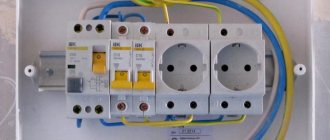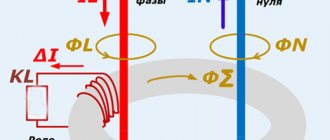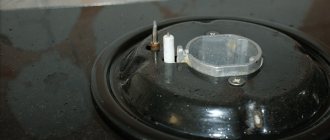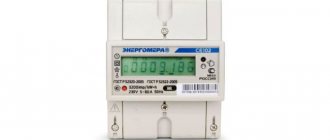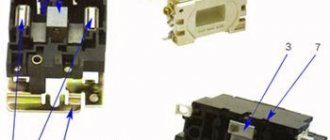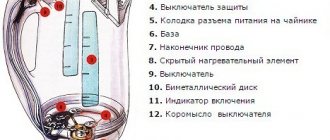Every year the number and variety of equipment in apartments and houses increases. In such conditions, the likelihood of electric shock or various injuries increases significantly. To avoid such situations, various devices are used - “automatic machines” and others. In order to understand what an RCD is, it is worth carefully studying its characteristics and purpose. If the question arises as to why an RCD is needed, then first of all this device provides protection to users from electric shock.
RCD complete with cord for a conventional water heater Source remont-vodonagrevateley.ru
Operating principle of the device
Unlike a standard “machine”, when installing an RCD, two conductors are connected to it - the working zero and the phase. If an electrical device operates without leaks, then the current strength in the conductors should be the same. In emergency situations, when a current leak occurs, the device turns off. As a result, the electrical device is de-energized and stops working. Thus, the RCD helps preserve the health and life of ordinary users.
The RCD protects the house from fire and controls electrical wiring and equipment from current leakage Source electro-king.com.ua
All equipment has a slight current leakage. But usually its level is not sufficient to cause harm to human health. All RCDs are set to the level of electrical energy that poses a danger to people or will lead to disruption of electrical appliances.
The speed of automatic shutdown is such that a child who stuck a nail into the socket will not even experience any discomfort - the device will automatically turn off the power in the entire house.
After automatic shutdown of the device, it is necessary to detect a current leak Source zen.yandex.uz
RCDs are developed in accordance with GOST 31603-2012
Portable residual current devices for household and similar purposes, controlled by differential current, without built-in overcurrent protection (RCD-DP). General requirements and test methods
Unlike a machine, the protective shutdown opens the circuit as soon as voltage reaches the housing - this was the decisive factor for its installation.
Nikolai
RCD connection diagram in an apartment
Electricians advise installing RCDs only on equipment that requires compliance with increased safety standards, for example - a washing machine, boiler, electric stove, microwave oven. There is no need to connect the lighting in the apartment through an RCD, since if conventional lamps burn out, there will be a power outage in the entire apartment.
Attention! The most convenient place to locate an RCD in an apartment is a place next to the power source. Usually it is installed next to the meter, in the electrical panel at the entrance to the premises.
Let's consider how this device can be connected to an apartment.
The RCD connection is carried out according to two common schemes - TN-C and TN-CS:
- TN-C system.
- TN-CS system.
TN-C circuit
The most popular, consisting of one common conductor acting as grounding and one working neutral conductor. This scheme is one of the most reliable.
This circuit includes a neutral and grounding wire, combined into one common conductor, which is divided after entering the room into two conductors N (zero) and PE (grounding). This option is less common in our housing construction.
TN-CS circuit
Reasons for automatic shutdown of RCDs
Before starting repairs, it is worth finding out why the RCD is triggered. There may be several reasons for this phenomenon, and the method and cost of repairs depend on them.
- Current leakage in the network . This problem often occurs in buildings with old wiring. Over time, the insulating coating loses its elasticity, cracks, and the wiring is exposed in some areas. If the wiring has been installed recently, it is worth checking the quality of the wire connections. Sometimes an accidentally driven nail can damage the insulation layer. A conventional machine does not respond to current leaks, so the RCD is designed to provide adequate protection.
- Malfunction of the device to which the RCD is connected . Among the damages, the most common failure is the failure of the cord, motor winding or heating element of the water heater.
- Installation error . If the device is installed incorrectly, the automation may periodically operate for no reason. Before installing the device, you should carefully study the instructions or use the services of a specialist.
When installing, it is important not to make mistakes, otherwise the device will turn off for no apparent reason Source www.ets96.ru
- Incorrect device selection . When purchasing a unit, it is important to take into account all its characteristics and purpose. Failure to comply with these parameters may result in a false shutdown.
- Human touching a wire without insulation . In fact, this device is designed specifically to protect a person in such situations.
- Damage to the mechanism itself . Sometimes the trigger mechanism is damaged, and the slightest vibration triggers an automatic shutdown.
- Incorrect placement of the device in the electrical wiring . To avoid this problem, it is worth installing the device after the meter and in front of the machine. If there are many electrical appliances with high power in the house, then you should use several devices for each group. This will allow you not to turn off the power in the entire house in case of problems, but only in certain areas.
- According to the rules of the PUE, grounding and working zero cannot be combined . But sometimes electricians do not take this prohibition into account. A short circuit of these two lines may occur, which will cause the RCD to automatically turn off.
Installing conventional machines is much easier. To install the protective shutdown, we had to contact specialists.
Basil
During installation, you must adhere to all safety requirements Source repair-need.ru
- Weather conditions . A machine installed outdoors is susceptible to moisture. As a result, moisture accumulates in the internal mechanism, a leak occurs, and the machine is triggered. If there are minor current leaks in the house, then lightning during a thunderstorm can intensify them. This is also the reason for automatic shutdown. At very low temperatures, the device's microcircuits may fail, and the RCD simply will not work in cases of current leakage.
- High level of humidity in the room . If you tried to hide the installed wiring using putty, then connect the electricity after drying, otherwise the automatic protection may work.
To ensure safety, all wires must be connected correctly Source kakpravilnosdelat.ru
See also: Catalog of companies that specialize in electrical work.
Types of residual current devices
Each device processes a flow with a certain fluctuation and nominal value.
The parameters are indicated on the device body. In addition to the maximum possible passing current, RCDs are divided according to characteristics :
- number of poles;
- installation method;
- operating voltage.
The number of poles corresponds to the number of conductors. There is an RCD with four terminals for working with a three-wire or two-wire highway. The device is mounted permanently or portable options are used. For a single-phase network, devices are produced for 220V , for a three-phase network - 400V .
Electromechanical
It always works if there is a loss of electricity in the area, regardless of the presence of voltage.
Features of the electromechanical device:
- the main unit is a differential electromagnetic transformer in the form of a core with wound windings;
- losses of electricity in the area cause voltage to appear on the secondary winding, the relay and machine are activated;
- To connect to the network, you need to study the electrical connection diagram shown on the device box.
There are some differences in the installation of the electromechanical and electronic versions. The diagram of the first shows that zero and phase pass through the transformer, and the relay is connected to the secondary winding.
Electronic
Such installations switch off only when voltage is present, so they require an additional power source to operate.
Features of electronic RCD:
- main module - an electronic dielectric plate with an amplifier, which does not function without an external supply of electricity;
- there are no batteries inside the device;
- if there is 220 V in the main line, the RCD will turn off the supply; if there is no voltage, the machine will not react.
Valera
The voice of the construction guru
Ask a Question
This situation is dangerous in some situations, for example, when a zero burns out on a common shield. Household appliances do not work because there is no voltage. But the phase does not disappear anywhere; if the insulation is broken, it can end up on the box of the household appliance. When touched by a person, an electromechanical RCD will react, but an electronic one will not. The second situation is when voltage surges in the network damage the board with the amplifier. There is no external damage, but if a person touches conductive elements, the protection will not work. Electronic RCDs have a “Test” button, which is turned on for testing at least once a month.
Selective
This type of automation is connected in series, separately for each consumer circuit, for example, for different rooms, for lighting and socket groups, for connecting powerful equipment.
Features of the selective apparatus:
- selectivity when switching off (individual sections);
- avoiding blackout of neighboring groups.
If an emergency situation occurs in household appliances (insulation failure), potential will accumulate on the box. With a three-wire network with grounding, the protection will instantly turn off the device. With a two-wire line without grounding, the RCD will react when a person touches the body.
Fire protection
Such devices are installed in cascade circuits, multi-level systems as the first response of differential protection. They do not protect against electric shock.
Main goals:
- input cable protection;
- protection of consumer circuits without differential protection;
- additional protection if the previously installed automatic switch does not work.
Fire protection devices must have high current sensitivity, and the response time must be delayed by a fraction of a second.
How to find the area where there is a leak
In order to find out the reason why the RCD knocks out, you should take the following steps:
- Carefully check that the connection is correct . Installation errors are the main reasons for automatic operation.
- To check each area or electrical appliance, you should turn off the circuit breakers and protection on each line : kitchen, bathroom, lighting, appliances.
- When the machines are running, it is necessary to enable leakage protection . If the RCD trips while the product is running, it means there is a malfunction in the mechanism. If automatic protection does not work, then the following mechanisms should be checked.
- To check the integrity of the electrical wiring, it is necessary to disconnect all electrical appliances in the house from the power supply and turn on the input circuit breaker and connect the electricity . If the RCD trips, then the problem is in the wiring. If everything works as usual, then the reason is technical.
If there is a leak in the electrical wiring, then it is necessary to check the entire system Source m.yukle.mobi
Troubleshooting
By checking each individual device, you can find out which of them has a malfunction. When connecting faulty equipment to the RCD, the protection will automatically operate. The most common problems occur in the operation of washing machines, electric ovens and water heaters. To solve this problem, you should not open the equipment yourself. To fix the problem, you should contact a service center or call a specialist to your home.
If the problem is in the old electrical wiring, then it often has to be changed completely. If the lines were laid recently, then it is worth looking for errors in connections, connecting wires or weak machines. It is necessary to inspect distribution boxes and sockets. If the automation is triggered when the lighting is turned on, the reason may be in the lighting device itself. Also, do not neglect checking the cable along the entire line. If there is open wiring in the room, this makes the task easier. To diagnose closed wiring, you should use a special device. It helps to find the location of the cable break.
For a number of reasons, we had to do open wiring in the office. I was really happy about it when the time came to expand - it turned out that machines and additional lines could be added without any problems.
Alexei
Clamps for measuring current leakage Source test-energy.ru
Finding out the reasons for the operation of the RCD is a long and troublesome process that requires a lot of time and patience.
Safety rules during work
Most of the rules are of a general nature, that is, they must be applied in the process of any electrical installation work.
If you decide to equip the electrical distribution panel yourself, before installing and connecting the RCD, do not forget:
- turn off the power supply - turn off the machine at the entrance;
- use wires with appropriate color markings;
- do not use metal pipes or fittings in the apartment for grounding;
- First of all, install an automatic input switch.
If possible, it is recommended to use separate devices for lighting lines, sockets, washing machine circuits, etc. Otherwise, installing a common RCD is sufficient.
To protect children, all electrical installations in a children's room are usually combined into one circuit and equipped with a separate device. Instead of an RCD, you can use a difavtomat
In addition to the characteristics of the devices themselves, the parameters of other electrical wiring elements are also important, for example, the cross-section of the electrical wire. It should be calculated taking into account the constant load.
It is better to connect the wires to each other using terminal blocks, and to connect to devices, use specially designed, marked terminals, as well as a diagram on the case.
Features of choosing an RCD
Before you start choosing an RCD, you should determine the type of electrical wiring, analyze the operational features of the room and select a connection diagram for the device for protection.
There are RCDs on sale with different limiting values of differential currents. Each device has its own purpose. For household use, devices with levels of 10 mA, 30 mA, or 100 mA are used. This is usually sufficient to protect residential buildings or offices.
Types of RCDs must be selected in accordance with specific conditions Source samodomik.ru
The standard version of the device is not able to disconnect power contacts if the network is overloaded, or protect the wiring from short circuits. To avoid unpleasant situations, it is worth supplementing the protection with automatic switches or other protective mechanisms.
Also, every buyer should know how to check the RCD. For this purpose, each device has a test button. When it is pressed, current leaks and the power contacts should automatically turn off.
When you press the test button, the device should turn off Source electrikmaster.ru
Main operating characteristics of RCDs
In order for the device to work at the right time, it must be selected correctly according to its operating characteristics and connected.
The main parameter is the rated current value. This is the maximum current that this device can withstand over a long service life, remaining in working order and maintaining its protective characteristics. You will find this number on the front panel of the device; it must correspond to one of the readings in the standard series - 6, 10, 16, 25, 32, 40, 63, 80, 100 A. This RCD parameter depends on the load of the protected line and the cross-section of the conductors.
The RCD connection diagram provides for the joint installation of this device with circuit breakers.
This is important to remember, because the RCD only protects against current leaks, and the machine will react to disconnecting the circuit in short circuit and overload mode. The video shows whether it is possible to connect an RCD if there is no grounding in the apartment:
The video shows whether it is possible to connect an RCD if there is no grounding in the apartment:
In terms of rated current, the RCD must be selected an order of magnitude higher than the machine installed in pair with it.
The next important parameter is the rated residual current. This is the required leakage current value to turn off the RCD. There is also a standard series for differential currents, the values in which are normalized in milliamps - 6, 10, 30, 100, 300, 500 mA. But on an RCD this figure is indicated in amperes - respectively, 0.006, 0.01, 0.03, 0.1, 0.3, 0.5 A. You will also find this parameter on the device body.
To protect people at the RCD, it is necessary to set the leakage current setting to 30 mA, because values that are higher will lead to injury, electrical injury and even death. Since the environment in damp rooms is considered the most dangerous, a setting of 10 mA is selected on the RCDs protecting them.
We hope that by understanding the main purpose of the RCD and the principle of its operation, you will not neglect this important element of protection and make your life safe.
Types of RCD
A large selection of appliances often confuses the buyer. Each device has different technical parameters that should be taken into account when purchasing. They cannot be changed or configured during operation, so it is better to immediately purchase a device with the required technical characteristics.
- Automatic shutdown speed . An ordinary household appliance works instantly. But there are multi-level systems where sequential shutdown is important. For such cases, selective RCDs are purchased that disconnect power contacts with some delay.
Circuit with selective RCDs Source yaelectrik.ru
- Type of current . There are two types of devices - AC and A. The first type is switched off if an AC leak is detected, and the second type is switched off if there are problems with direct and alternating current. In industry, RCDs with the designation B are used. They are suitable for direct and rectified current. The letters S or G may also be added to the marking. They indicate a shutdown delay.
- Type of relay . There are electronic and electromechanical options. Electromechanical relays break the contacts mechanically, and in electrical versions the power is interrupted using semiconductor systems.
Protective device with electromechanical relay Source www.etm.ru
Full decoding of marking values
The name of the developer company must be on the device body. This is followed by standardized markings indicating the serial number.
To decipher the abbreviation we will use the following example [F][X]00[X]-[XX] :
- [F] – residual current device;
- [X] – performance format;
- 00 – digital or alphanumeric designations of the series;
- [X] – number of poles: 2 or 4;
- [XX] – characteristics by type of leakage current: AC, A and B.
The nominal parameters of the device will also be indicated here, which you need to pay special attention to when choosing.
Explanation of the abbreviation: 1 – brand; 2 – device type; 3 – selective species; 4 – compliance with European standards; 5 – rated operating current and setting; 6 – maximum alternating operating voltage; 7 – rated current that the device can withstand; 8 – differential making and breaking capacity; 9 – electrical diagram; 10 – manual performance check; 11 – switch position marking
The maximum parameters for which the devices are designed include: voltage Un , current In , differential value of the circuit breaking current IΔn , switching capacity Im, switching capacity for short circuits Icn .
The main markings must be located in such a way that they remain visible after installation of the device. Some parameters may be marked on the side or on the rear panel, visible only before installation of the product.
Outputs intended only for connecting the neutral wire are designated by the Latin symbol “ N ”. The disabled RCD mode is indicated by the symbol “ O ” (circle), and the activated mode is indicated by a short vertical line “ I ”.
Not every product is marked with optimal environmental temperature indicators. In those models where there is a symbol, this means that the operating range is from -25 to + 40 °C; if there are no symbols, this means standard indicators from -5 to +40 °C.
Features of choosing an RCD connected to a water heater
In domestic conditions, storage and instantaneous electric water heaters are used. Using the device, along with a machine, protects equipment from current leakage or fire. An RCD for a water heater is installed directly in front of the device itself, and the electrical energy that powers the equipment passes through it. In cases of current leakage, the device senses the changes and automatically turns off the power system. For this purpose, the device is equipped with special sensors and switches.
According to safety requirements, the RCD installed on the water heater must be supplemented with grounding. Also, to protect equipment from overloads or short circuits, boilers are additionally equipped with automatic switches.
RCD and difavtomat for additional protection of equipment Source strbuild.ru
Three-phase RCD and single-phase
As you know, there are two types of voltage in both domestic and industrial environments: single-phase and three-phase.
Accordingly, RCDs are divided according to the number of phases of the consumer’s power supply. Three-phase protection systems have four incoming and outgoing terminals. Three of which are connected to phases, and one to zero. A single-phase RCD uses two input terminals for connection and, accordingly, two at the output of the device. They should be connected after the power input circuit breaker and the meter, as shown in the figure. When connecting an RCD to a three-phase circuit, one nuance must be taken into account. If this is a consumer with symmetrical loads on each phase, for example an asynchronous motor, then the neutral wire does not need to be connected to the protective device. It is enough to simply ground the motor housing, as required by regulations and legal rules for the operation of electrical equipment. That is, with a single-phase power supply, an RCD system without grounding is very relevant.
If, in a three-phase circuit, each phase is connected to its own individual load with different powers, then the neutral wire is needed both to power each of these single-phase devices and to protect against insulation breakdown. For example, the following will be connected to a three-phase 380 V network:
- vacuum cleaner (one phase and zero), designed for 220 V;
- single-phase hair dryer to another phase;
- lighting with 220 volt lamps on third;
Here the neutral wire will have to be inserted directly into the protection device.
Protective grounding is a matter of course, since it is required by the rules, that is, all conductive housings of electrical equipment must be grounded.
This is the marking, RCD designation and its interpretation that is most often used.
In order to carry out work on the installation and connection of the RCD, it is necessary to turn off the input circuit breaker, and also provide protection against switching on by hanging a prohibitory poster “Do not turn on people working” and closing the electrical panel where it is located. The work itself cannot be called very complex in terms of electrical engineering knowledge, as practice shows, anyone can understand “what is an RCD in electrical engineering” and “what is an RCD for and why?” The main thing is to install the RCD correctly and select it correctly. Then it will reliably protect all personnel or family members from the dangerous effects of voltage in the event of a touch or breakdown.
Additional RCD functions
To protect human life and health, devices are used that detect leakage currents of 30 mA and 10 mA. All RCDs that have the highest indicators do not provide protection for human life. Very often, in multi-stage schemes, fire protection RCDs are used as the first stage of protection. These are fire protection RCDs that are set to leak current from 100 mA to 300 mA.
They are installed in distribution boards on each floor, or in metering boards. They perform the function of protecting the input cable and consumer lines that do not have separate protection. Also, these devices provide additional protection in case of malfunction of a downstream device or machine.
RCD in the distribution board Source www.drive2.com
In order for fire protection devices to successfully perform their function, devices with different sensitivity to current and different response times of automatic protection should be installed.
Even if you are not going to install anything other than automatic machines right now, I advise you to take a larger shield - if in the future you have to strengthen the circuit, or add more circuits, it will come in handy.
Kirill.
Checking the RCD for serviceability
In order to be sure that the device is in good working order, it should be checked not only before installation, but also during operation, approximately once a month. To find out how to test the RCD for functionality, you should read the instructions.
Each device has a large test button. Pressing it simulates an emergency current leak. If the RCD is working properly and all wires are connected correctly, then it should work regardless of the connection of household appliances to it. For such testing you do not need to have special knowledge or qualifications.
Each device must be tested once a month Source zoon.ru
How to calculate the device
The RCD is calculated based on operating conditions. If the network is single-phase, then a two-pole device is needed. In a three-phase network, four-pole devices are used.
The choice of device taking into account current leakage depends on the quality of wire insulation, length of wiring, number and power of devices.
When installing an RCD, you need to know that the total current of all network leaks and electrical devices should not be more than a third of the rated current of the device. If there is no information about the equipment, then with a load of 1 A, 0.4 mA of leakage is taken into account. Also, a network cable loses 10 µA per 1 m of length, because electrical energy can leak through ordinary insulation. This phenomenon complies with safety regulations.
An example of connecting an RCD to a group of machines in a three-phase network Source samodomik.ru
Main selection criteria
When choosing, you should be guided by the following basic criteria:
- type of electric current: alternating, constant, pulsating. Based on this, devices of types AC, A or B are selected;
- rated current of the RCD. Characterizes the maximum power that can be passed through the power contacts of the device;
- number of poles. The number of poles determines which electrical network the RCD is intended for: single-phase or three-phase. If the network is single-phase, then the device must be bipolar. If the network is three-phase, then the device is selected in a four-pole design;
- the presence or absence of a delay when turning off. An RCD can turn off the electrical network almost instantly, without any time delay. But the shutdown may occur with some time delay. The delay time is set during settings in the form of a time setting. Thus, according to the design of RCDs, they differ into types with a delay or without a time delay when disconnecting.
Appearance of a three-phase and single-phase device
